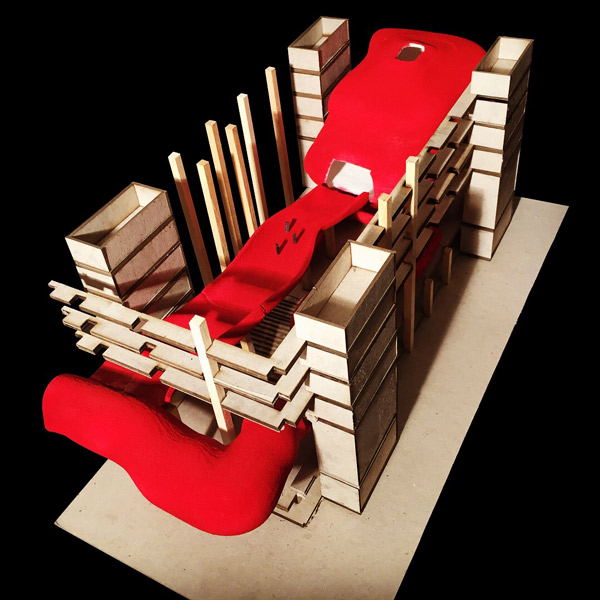

During peak studio hours, the Crough Center for Architectural Studies is alive with the sounds of scissors cutting, saws whirring, mouses clicking and the occasional pause of silence as the budding architect stops to reflect on his or her project.
University professor of architecture Eric Jenkins refers to this as the action/reflection cycle, or the process of making, reflecting and then responding to that reflection with new making. This cycle is one of the building blocks of the Catholic University Architecture curriculum that encourages students to work with their hands and embrace the physical nature of design.
“We do a very good job at preparing our students to move with fluidity between different media in model making,” Jenkins said. “We don’t tell our students which tool is best, but allow them to explore their abilities in drawing, physical model making and digital design and push them to produce high-quality work in many different media.”

Julia Pryor ('19) finds that the University’s emphasis on creativity in model making has helped her become a better and more confident architecture student. Her latest project consists of foam board, cut precisely in puzzle-like pieces and arranged to take on the form of an apartment complex.
“I am best at digital design,” said Pryor. “But I have had to work hard to build my skills and appreciate other design mediums, and I know that experience will be very helpful when I start looking for a job next year.”
Unlike other professions, Architects do not usually physically build their design themselves, but rely on others to construct. They also rarely have an opportunity to fix a project once it is constructed. This is why models are an important part of an architect’s process; its the only way to achieve a physical sense of the theoretical.
“Models are about communication,” said Jenkins. “They are analogs to the built world. We can hold a model in our hands and understand more than just the physical. We can grasp the ephemeral feeling that the building is trying to convey and that’s why model making is so emphasized in our school.”
Working with physical models also encourages students to push past the brick and mortar and see the deeper spirit in building design. Jenkins says that one of the things that sets Catholic students apart when entering the workforce is their thoughtfulness and ability to understand the spiritual element of a place.
“Our students have a strong sense of thoughtfulness and soul in everything they do,” said Jenkins. “Part of that stems from the fact that we are not a secular University. I can ask my students questions like ‘what is the nature of this, spiritually?’. We can talk about spirit and soul and God here.”
The University also makes a point of providing students encounters with beautiful buildings and spaces, including dozens of trips throughout the year to inspiring spots in the local Washington, D.C., area as well as trips abroad.
Emily Curato, a graduate student pursuing her Masters in Architecture and Planning and also a former University undergraduate, says one of her favorite things about studying at Catholic was the ability to travel and discover beautiful architectural spaces. Curato studied abroad for a semester in Rome through the University and took two school-led trips to northern Italy and Berlin. She also travelled to Japan using a University travel scholarship and visited London as part of a studio course sponsored by a local architecture firm.
“There’s nothing that can influence your understanding of proportion more than to literally be standing in the middle of it,” she said. “Traveling has greatly influenced my ability to understand design and space.”
This is the kind of physical encounter that Catholic University Architecture wants to make sure every student experiences, whether by studying a model or walking through a building.
Because, as Jenkins put it, teaching architecture is not just preparing students for concepts, but preparing them to engage physical space both intellectually and materially; to become thoughtful, well-balanced architects who both act and reflect.